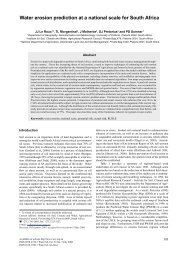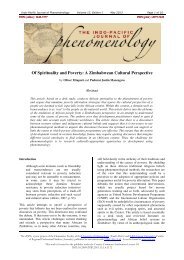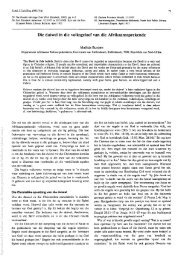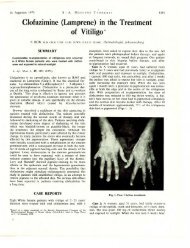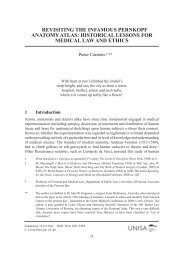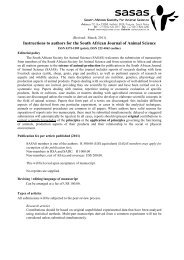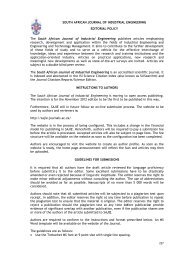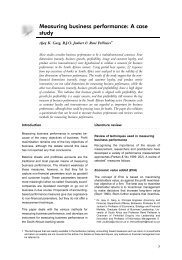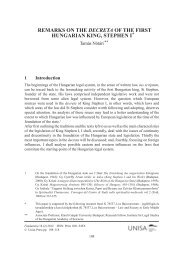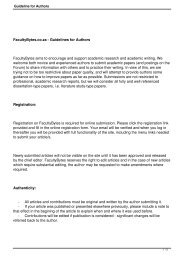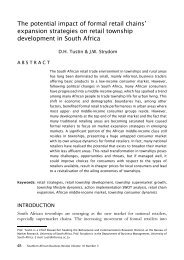Knowledge management practices at an institution of higher learning
Knowledge management practices at an institution of higher learning
Knowledge management practices at an institution of higher learning
Create successful ePaper yourself
Turn your PDF publications into a flip-book with our unique Google optimized e-Paper software.
Page 1 <strong>of</strong> 8<br />
Original Research<br />
<strong>Knowledge</strong> <strong>m<strong>an</strong>agement</strong> <strong>practices</strong> <strong>at</strong> <strong>an</strong> <strong>institution</strong> <strong>of</strong><br />
<strong>higher</strong> <strong>learning</strong><br />
Authors:<br />
Judith Mavodza 1<br />
P<strong>at</strong>rick Ngulube 2<br />
Affili<strong>at</strong>ions:<br />
1<br />
Zayed University Library,<br />
Zayed University, Abu Dhabi<br />
2<br />
Department <strong>of</strong><br />
Interdisciplinary Research,<br />
College <strong>of</strong> Gradu<strong>at</strong>e Studies,<br />
University <strong>of</strong> South Africa,<br />
South Africa<br />
Correspondence to:<br />
P<strong>at</strong>rick Ngulube<br />
Email:<br />
ngulup@unisa.ac.za<br />
Postal address:<br />
PO Box 392, UNISA 0003,<br />
South Africa<br />
D<strong>at</strong>es:<br />
Received: 15 Aug. 2011<br />
Accepted: 10 Aug. 2012<br />
Published: 05 Oct. 2012<br />
How to cite this article:<br />
Mavodza, J. & Ngulube,<br />
P., 2012, ‘<strong>Knowledge</strong><br />
<strong>m<strong>an</strong>agement</strong> <strong>practices</strong> <strong>at</strong> <strong>an</strong><br />
<strong>institution</strong> <strong>of</strong> <strong>higher</strong> <strong>learning</strong>’,<br />
SA Journal <strong>of</strong> Inform<strong>at</strong>ion<br />
M<strong>an</strong>agement 14(1), Art.<br />
#496, 8 pages. http://dx.doi.<br />
org/10.4102/sajim.v14i1.496<br />
Background: This article underscores the fact th<strong>at</strong> society is becoming more <strong>an</strong>d more<br />
knowledge-based, <strong>an</strong>d th<strong>at</strong> the org<strong>an</strong>is<strong>at</strong>ions th<strong>at</strong> c<strong>an</strong> identify, value, cre<strong>at</strong>e <strong>an</strong>d evolve<br />
their knowledge assets are likely to be more successful th<strong>an</strong> those th<strong>at</strong> do not. <strong>Knowledge</strong><br />
<strong>m<strong>an</strong>agement</strong> (KM) is about enh<strong>an</strong>cing the use <strong>of</strong> org<strong>an</strong>is<strong>at</strong>ional knowledge through sound<br />
<strong>practices</strong> <strong>of</strong> KM <strong>an</strong>d org<strong>an</strong>is<strong>at</strong>ional <strong>learning</strong>. KM <strong>practices</strong> encompass the capture <strong>an</strong>d/or<br />
acquisition <strong>of</strong> knowledge, its retention <strong>an</strong>d org<strong>an</strong>is<strong>at</strong>ion, its dissemin<strong>at</strong>ion <strong>an</strong>d re-use, <strong>an</strong>d<br />
lastly responsiveness to the new knowledge.<br />
Objective: The focus <strong>of</strong> this study was on KM principles <strong>an</strong>d <strong>practices</strong> th<strong>at</strong> may be in place<br />
in the Metropolit<strong>an</strong> College <strong>of</strong> New York (MCNY). The argument is th<strong>at</strong> KM <strong>an</strong>d its survival<br />
principles <strong>an</strong>d tools may help the College to improve perform<strong>an</strong>ce. However, there is<br />
uncertainty about whether the use <strong>of</strong> KM principles <strong>an</strong>d tools c<strong>an</strong> partly solve the College’s<br />
approach to improving the quality <strong>of</strong> educ<strong>at</strong>ion it provides.<br />
Methods: A mixed methods research methodology encompassing a questionnaire, observ<strong>at</strong>ion,<br />
interviews, <strong>an</strong>d use <strong>of</strong> <strong>institution</strong>al documents was used in the investig<strong>at</strong>ion.<br />
Results: The findings <strong>of</strong> the study indic<strong>at</strong>e th<strong>at</strong> KM concepts were not universally understood<br />
<strong>at</strong> MCNY.<br />
Conclusion: There is a need to cre<strong>at</strong>e a knowledge inventory <strong>at</strong> MCNY. This may help the<br />
College to develop appropri<strong>at</strong>e <strong>institution</strong>-wide policies <strong>an</strong>d <strong>practices</strong> for proper <strong>an</strong>d well<br />
org<strong>an</strong>ised methods <strong>of</strong> integr<strong>at</strong>ing work processes, collabor<strong>at</strong>ing <strong>an</strong>d sharing (including the<br />
efficient use <strong>of</strong> social media), <strong>an</strong>d developing <strong>an</strong> enabling <strong>institution</strong>al culture.<br />
Introduction<br />
Society has become more <strong>an</strong>d more knowledge-based. Therefore the org<strong>an</strong>is<strong>at</strong>ions th<strong>at</strong> c<strong>an</strong><br />
identify, value, cre<strong>at</strong>e <strong>an</strong>d evolve their knowledge assets are likely to be more successful th<strong>an</strong><br />
those th<strong>at</strong> do not. <strong>Knowledge</strong> in a modern org<strong>an</strong>is<strong>at</strong>ion is <strong>an</strong> essential resource especially because it<br />
is not readily replic<strong>at</strong>ed by rivals. Jain (2007) <strong>an</strong>d Senge (1994) point out th<strong>at</strong> some org<strong>an</strong>is<strong>at</strong>ions<br />
are unable to function as knowledge-based org<strong>an</strong>is<strong>at</strong>ions because they have <strong>learning</strong> disabilities.<br />
It is import<strong>an</strong>t for <strong>an</strong> org<strong>an</strong>is<strong>at</strong>ion to have a clear underst<strong>an</strong>ding <strong>of</strong> wh<strong>at</strong> knowledge <strong>m<strong>an</strong>agement</strong><br />
(KM) me<strong>an</strong>s to its oper<strong>at</strong>ions if it needs to consider using those KM <strong>practices</strong> th<strong>at</strong> enh<strong>an</strong>ce<br />
efficiency <strong>an</strong>d lend value to org<strong>an</strong>is<strong>at</strong>ional knowledge. In this way knowledge becomes a str<strong>at</strong>egic<br />
resource (Kok 2012).<br />
These <strong>practices</strong> include knowledge gener<strong>at</strong>ion, which encompasses activities th<strong>at</strong> bring to light<br />
all the knowledge th<strong>at</strong> is new to a group or to <strong>an</strong> individual. <strong>Knowledge</strong> gener<strong>at</strong>ion comprises the<br />
exploit<strong>at</strong>ion <strong>of</strong> existing knowledge to cre<strong>at</strong>e new knowledge, as well as finding new knowledge<br />
through interacting <strong>an</strong>d collabor<strong>at</strong>ing with other individuals or systems (Nonaka 1991; Nonaka<br />
& Takeuchi 1995; Nonaka & Teece 2001). This process therefore involves the acquisition <strong>of</strong><br />
knowledge if it is to be successful. The acquired knowledge is <strong>of</strong> limited value if it is not org<strong>an</strong>ised<br />
<strong>an</strong>d stored for easy retrieval. Once it is available for retrieval, there is a need to have systems th<strong>at</strong><br />
enable its sharing <strong>an</strong>d tr<strong>an</strong>sfer. A process <strong>of</strong> knowledge retention results when <strong>an</strong> org<strong>an</strong>is<strong>at</strong>ion<br />
is able to facilit<strong>at</strong>e the capture <strong>an</strong>d tr<strong>an</strong>sfer <strong>of</strong> both formal <strong>an</strong>d informal knowledge through<br />
knowledge networking, thereby using the available intellectual capital to its adv<strong>an</strong>tage.<br />
© 2012. The Authors.<br />
Licensee: AOSIS<br />
OpenJournals. This work<br />
is licensed under the<br />
Cre<strong>at</strong>ive Commons<br />
Attribution License.<br />
As <strong>an</strong> academic <strong>institution</strong>, the Metropolit<strong>an</strong> College <strong>of</strong> New York (MCNY) oper<strong>at</strong>es in the new<br />
knowledge-based inform<strong>at</strong>ion environment th<strong>at</strong> is characterised by radical <strong>an</strong>d discontinuous<br />
ch<strong>an</strong>ges. This carries a new m<strong>an</strong>d<strong>at</strong>e for knowledge cre<strong>at</strong>ion <strong>an</strong>d implement<strong>at</strong>ion in order to<br />
get benefits th<strong>at</strong> are <strong>at</strong> the core <strong>of</strong> its educ<strong>at</strong>ion mission. Preparing students to meet the needs<br />
<strong>of</strong> today’s society is one <strong>of</strong> the direct benefits <strong>of</strong> the use <strong>of</strong> KM <strong>practices</strong>. In this perspective,<br />
the main challenge for MCNY is to develop <strong>an</strong>d implement KM processes in order to make<br />
its educ<strong>at</strong>ional mission relev<strong>an</strong>t to society. The challenge coincides with the concern raised by<br />
http://www.sajim.co.za<br />
doi:10.4102/sajim.v14i1.496
Page 2 <strong>of</strong> 8<br />
Original Research<br />
Cohen (1989), the founder <strong>of</strong> the College, who expressed the<br />
sentiment th<strong>at</strong> knowledge <strong>at</strong> the College was org<strong>an</strong>ised to<br />
encourage its practical applic<strong>at</strong>ion in hum<strong>an</strong> service practice<br />
<strong>an</strong>d perform<strong>an</strong>ce. This article aims to discuss the concepts,<br />
tools, processes <strong>an</strong>d requirements <strong>of</strong> KM <strong>practices</strong> <strong>an</strong>d their<br />
relev<strong>an</strong>ce to reaching the goal <strong>of</strong> quality educ<strong>at</strong>ion <strong>at</strong> MCNY.<br />
Types <strong>of</strong> knowledge <strong>an</strong>d knowledge<br />
<strong>m<strong>an</strong>agement</strong><br />
As do m<strong>an</strong>y <strong>higher</strong> educ<strong>at</strong>ion environments, MCNY<br />
possesses explicit knowledge in the form <strong>of</strong> fin<strong>an</strong>cial records<br />
necessary for meeting tax, payroll or accounting oblig<strong>at</strong>ions,<br />
files <strong>of</strong> import<strong>an</strong>t historical documents, self-study<br />
documents, research articles, conference proceedings, <strong>an</strong>d<br />
minutes <strong>of</strong> meetings. Photo albums <strong>an</strong>d similar mementos <strong>of</strong><br />
college activities <strong>an</strong>d interests form part <strong>of</strong> the knowledge<br />
asset, as well as library d<strong>at</strong>abases. Townley (2001) points<br />
out th<strong>at</strong> research <strong>an</strong>d scholarship are the t<strong>an</strong>gible assets <strong>of</strong><br />
<strong>an</strong> academic <strong>institution</strong>. In addition to these t<strong>an</strong>gible explicit<br />
knowledge assets there are the tacit or implied knowledge <strong>an</strong>d<br />
hum<strong>an</strong> expertise <strong>of</strong> the people who work in the org<strong>an</strong>is<strong>at</strong>ion,<br />
as well as everything th<strong>at</strong> is contained in the intr<strong>an</strong>ets.<br />
KM facilit<strong>at</strong>es the utilis<strong>at</strong>ion <strong>an</strong>d integr<strong>at</strong>ion <strong>of</strong> tacit <strong>an</strong>d<br />
explicit knowledge. It emphasises ‘collabor<strong>at</strong>ive <strong>learning</strong>, the<br />
capture <strong>of</strong> tacit knowledge, <strong>an</strong>d value-add obtained through<br />
best <strong>practices</strong> <strong>an</strong>d d<strong>at</strong>a mining’ (G<strong>an</strong>dhi 2004:373). Rowley<br />
(2003), Singh (2007), <strong>an</strong>d Wen (2005) highlight the fact th<strong>at</strong><br />
KM encompasses both the <strong>m<strong>an</strong>agement</strong> <strong>of</strong> people <strong>an</strong>d <strong>of</strong><br />
inform<strong>at</strong>ion. On the other h<strong>an</strong>d, Barquin (2001) describes<br />
KM as a process with phases <strong>an</strong>d components, embedded in<br />
time. There is more th<strong>an</strong> one approach to this process; it has<br />
different structures <strong>an</strong>d architectures, <strong>an</strong>d there are expected<br />
outcomes <strong>an</strong>d perform<strong>an</strong>ce to be measured. Concurring<br />
with this view, Kok (2012) also points out the import<strong>an</strong>ce<br />
<strong>of</strong> identifying ownership <strong>an</strong>d the source <strong>of</strong> knowledge, <strong>an</strong>d<br />
providing mech<strong>an</strong>isms <strong>an</strong>d incentives for sharing knowledge<br />
without possessiveness. The same point is expressed by<br />
Singh (2007:172) who is also <strong>of</strong> the view th<strong>at</strong> KM ‘implies the<br />
process <strong>of</strong> tr<strong>an</strong>sforming inform<strong>at</strong>ion <strong>an</strong>d intellectual assets<br />
into enduring value’. In practice this leads to a process <strong>of</strong><br />
the interpreting <strong>an</strong>d utilising <strong>of</strong> collective intelligence by a<br />
community <strong>of</strong> particip<strong>an</strong>ts.<br />
KM <strong>practices</strong> in <strong>higher</strong> educ<strong>at</strong>ion are actions aimed<br />
<strong>at</strong> improving the internal flow <strong>an</strong>d use <strong>of</strong> inform<strong>at</strong>ion<br />
through knowledge acquisition <strong>an</strong>d knowledge sharing for<br />
<strong>institution</strong>al effectiveness (Kidwell, V<strong>an</strong>der Linde & Johnson<br />
2000; Williams et al. 2004). From the definitions given, it<br />
appears th<strong>at</strong> KM is a process th<strong>at</strong> enables <strong>an</strong> org<strong>an</strong>is<strong>at</strong>ion<br />
to improve its perform<strong>an</strong>ce by enabling <strong>learning</strong> <strong>an</strong>d<br />
innov<strong>at</strong>ion whilst solving its problems, acknowledging <strong>an</strong>d<br />
resolving gaps in its oper<strong>at</strong>ions, <strong>an</strong>d recognising knowledge<br />
(comprising people <strong>an</strong>d inform<strong>at</strong>ion) as <strong>an</strong> org<strong>an</strong>is<strong>at</strong>ional<br />
asset which has to be m<strong>an</strong>aged through enabling policies <strong>an</strong>d<br />
<strong>institution</strong>al tools.<br />
The knowledge <strong>m<strong>an</strong>agement</strong><br />
process <strong>an</strong>d flow<br />
Recognising knowledge as <strong>an</strong> asset <strong>an</strong>d using it cre<strong>at</strong>ively<br />
does not always occur in <strong>an</strong> obvious m<strong>an</strong>ner. Nonaka <strong>an</strong>d<br />
Takeuchi (1995) suggest th<strong>at</strong> knowledge is tr<strong>an</strong>sferred<br />
from one form to <strong>an</strong>other because <strong>of</strong> a continuous process<br />
<strong>of</strong> interaction between tacit <strong>an</strong>d explicit knowledge in <strong>an</strong><br />
org<strong>an</strong>is<strong>at</strong>ion. The result is the ability to cre<strong>at</strong>e new knowledge<br />
which has economic worth <strong>an</strong>d is essential for innov<strong>at</strong>ion.<br />
For this to take place, a space called Ba (Nonaka & Konno<br />
1998), where knowledge is cre<strong>at</strong>ed <strong>an</strong>d shared through social<br />
media, is needed. According to Nonaka <strong>an</strong>d Konno (1998):<br />
Ba c<strong>an</strong> be thought <strong>of</strong> as a shared space for emerging rel<strong>at</strong>ionships.<br />
This space c<strong>an</strong> be physical (e.g., <strong>of</strong>fice, dispersed business<br />
space), virtual (e.g., e-mail, teleconference), mental (e.g., shared<br />
experiences, ideas, ideals), or <strong>an</strong>y combin<strong>at</strong>ion <strong>of</strong> them. Wh<strong>at</strong><br />
differenti<strong>at</strong>es Ba from ordinary hum<strong>an</strong> interaction is the concept<br />
<strong>of</strong> knowledge cre<strong>at</strong>ion. Ba provides a pl<strong>at</strong>form for adv<strong>an</strong>cing<br />
individual <strong>an</strong>d/or collective knowledge. It is from such a pl<strong>at</strong>form<br />
th<strong>at</strong> a tr<strong>an</strong>scendental perspective integr<strong>at</strong>es all inform<strong>at</strong>ion<br />
needed. Ba may also be thought <strong>of</strong> as the recognition <strong>of</strong> the self in<br />
all. According to the theory <strong>of</strong> existentialism, Ba is a context which<br />
harbors me<strong>an</strong>ing. Thus, we consider Ba to be a shared space th<strong>at</strong><br />
serves as a found<strong>at</strong>ion for knowledge cre<strong>at</strong>ion. (p. 40)<br />
This expl<strong>an</strong><strong>at</strong>ion suggests th<strong>at</strong> spaces are Ba <strong>an</strong>d each<br />
knowledge conversion mode is associ<strong>at</strong>ed with its own<br />
Ba. Identifying <strong>an</strong>d using the spaces as well as consciously<br />
oper<strong>at</strong>ing in the knowledge conversion mode supports the<br />
evolving needs <strong>of</strong> a typical educ<strong>at</strong>ional establishment to<br />
benefit from its knowledge capital. However, Chou <strong>an</strong>d He<br />
(2004) point out th<strong>at</strong> they do not find a comprehensive <strong>an</strong>d<br />
feasible model th<strong>at</strong> deline<strong>at</strong>es the interrel<strong>at</strong>ionships between<br />
knowledge assets, <strong>an</strong>d th<strong>at</strong> knowledge cre<strong>at</strong>ion processes<br />
are absent.<br />
It may well be th<strong>at</strong> the concern raised by Chou <strong>an</strong>d He (2004)<br />
will be resolved by me<strong>an</strong>s <strong>of</strong> system<strong>at</strong>ic <strong>an</strong>d repe<strong>at</strong>ed studies<br />
<strong>of</strong> actual practice. The potential <strong>an</strong>d environment to capture,<br />
cre<strong>at</strong>e <strong>an</strong>d use knowledge assets were present <strong>at</strong> MCNY.<br />
St<strong>at</strong>ement <strong>of</strong> the problem<br />
Library support <strong>at</strong> MCNY is in the form <strong>of</strong> print <strong>an</strong>d online<br />
resources, reference services <strong>an</strong>d inform<strong>at</strong>ion literacy classes<br />
for all library users. The library currently suffers from <strong>an</strong><br />
inability to provide every resource <strong>an</strong>d service th<strong>at</strong> the<br />
students <strong>an</strong>d faculty require. This is confirmed by the MCNY<br />
Self-Study (2009:51) which st<strong>at</strong>es th<strong>at</strong> there is consensus<br />
amongst students <strong>an</strong>d staff th<strong>at</strong> ‘library resources <strong>an</strong>d<br />
services are not adequ<strong>at</strong>e’. The reasons are fin<strong>an</strong>cial as well<br />
as practical. Firstly, the library c<strong>an</strong>not survive in isol<strong>at</strong>ion <strong>an</strong>d<br />
provide everything th<strong>at</strong> the College library users need. The<br />
cost <strong>of</strong> books <strong>an</strong>d other inform<strong>at</strong>ion resources has become too<br />
prohibitive to cope with, so networking with other librari<strong>an</strong>s<br />
<strong>an</strong>d libraries for interlibrary lending <strong>an</strong>d discounts when<br />
purchasing m<strong>at</strong>erial have become essential, but are still not<br />
sufficient. Secondly, if the money were available to buy every<br />
http://www.sajim.co.za<br />
doi:10.4102/sajim.v14i1.496
Page 3 <strong>of</strong> 8<br />
Original Research<br />
book <strong>an</strong>d every upd<strong>at</strong>e <strong>an</strong>d new edition on the market, space<br />
limit<strong>at</strong>ions would be prohibitive. The floor <strong>an</strong>d shelf space<br />
<strong>at</strong> the MCNY library c<strong>an</strong>not accommod<strong>at</strong>e limitless numbers<br />
<strong>of</strong> books.<br />
Thirdly, there are now so m<strong>an</strong>y resources provided online<br />
th<strong>at</strong> the library has to find a bal<strong>an</strong>ce between wh<strong>at</strong> is<br />
available in print <strong>an</strong>d wh<strong>at</strong> is available online. Fourthly, with<br />
staff cuts th<strong>at</strong> have taken place due to a shrinking budget, it is<br />
not possible to have a robust library staff complement to give<br />
sufficient <strong>at</strong>tention to individual library users’ needs. Fifthly,<br />
the library is a department within the larger <strong>institution</strong><br />
<strong>an</strong>d to a large extent oper<strong>at</strong>es within the m<strong>an</strong>agerial <strong>an</strong>d<br />
org<strong>an</strong>is<strong>at</strong>ional parameters <strong>of</strong> the <strong>institution</strong>. This me<strong>an</strong>s<br />
th<strong>at</strong> decisions th<strong>at</strong> may seem best suited for the library are<br />
not necessarily acceptable unless they give adv<strong>an</strong>tage <strong>an</strong>d<br />
enh<strong>an</strong>ce relev<strong>an</strong>ce to the <strong>institution</strong> as a whole. In addition to<br />
these challenges, a new inform<strong>at</strong>ion environment has brought<br />
additional dem<strong>an</strong>ds. Despite the given circumst<strong>an</strong>ces, the<br />
library is still expected to provide a consistently efficient <strong>an</strong>d<br />
effective quality service.<br />
Following the question raised by Creswell (2007:102), ‘Why<br />
is this study needed’, <strong>an</strong>d the suggestions <strong>of</strong> Hernon <strong>an</strong>d<br />
Schwartz (2007:307) th<strong>at</strong> the st<strong>at</strong>ement <strong>of</strong> the problem should<br />
‘withst<strong>an</strong>d a reviewer raising the “so wh<strong>at</strong>” question’, the<br />
problem st<strong>at</strong>ement in this case would be th<strong>at</strong> the MCNY<br />
library is providing a service th<strong>at</strong> needs quality improvement<br />
as it does not adequ<strong>at</strong>ely address challenges posed by<br />
a fast-ch<strong>an</strong>ging inform<strong>at</strong>ion environment. However, no<br />
documented study has investig<strong>at</strong>ed why this is so <strong>an</strong>d wh<strong>at</strong><br />
needs to be done to improve the situ<strong>at</strong>ion.<br />
There is uncertainty about whether the use <strong>of</strong> KM principles<br />
<strong>an</strong>d tools c<strong>an</strong> partly solve the library’s approach to improving<br />
the quality <strong>of</strong> its service to its community in the modern<br />
inform<strong>at</strong>ion environment. KM has been implemented in<br />
commercial <strong>an</strong>d business environments for the sake <strong>of</strong><br />
oper<strong>at</strong>ional adv<strong>an</strong>tages <strong>an</strong>d fin<strong>an</strong>cial gains. It may be possible<br />
th<strong>at</strong> KM survival principles <strong>an</strong>d tools would help the library<br />
to improve its perform<strong>an</strong>ce <strong>an</strong>d fulfil its m<strong>an</strong>d<strong>at</strong>e. Because<br />
librari<strong>an</strong>s serve users who also consume the products <strong>of</strong> the<br />
retail, entertainment <strong>an</strong>d mass media industries, their efforts<br />
have become more focussed towards cre<strong>at</strong>ing library spaces<br />
th<strong>at</strong> are inviting, dynamic <strong>an</strong>d exciting for the library users.<br />
These entail, amongst other things, the implement<strong>at</strong>ion <strong>of</strong><br />
Web 2.0 technologies. Web 2.0 is the second gener<strong>at</strong>ion <strong>of</strong><br />
web-based services <strong>an</strong>d tools th<strong>at</strong> emphasise online sharing<br />
<strong>an</strong>d collabor<strong>at</strong>ion amongst users. They are not KM, but c<strong>an</strong><br />
be used as tools in KM practice.<br />
The research problem is further addressed by looking <strong>at</strong><br />
the research questions <strong>an</strong>d possible sources <strong>of</strong> d<strong>at</strong>a. In the<br />
process <strong>of</strong> investig<strong>at</strong>ing the library-rel<strong>at</strong>ed problem KM<br />
<strong>practices</strong> th<strong>at</strong> are relev<strong>an</strong>t to the entire College are revealed.<br />
Research questions<br />
Research questions are used for obtaining both qualit<strong>at</strong>ive<br />
<strong>an</strong>d qu<strong>an</strong>tit<strong>at</strong>ive d<strong>at</strong>a. Specific questions th<strong>at</strong> informed<br />
this research are:<br />
• Wh<strong>at</strong> do librari<strong>an</strong>s, faculty, <strong>an</strong>d administr<strong>at</strong>ors underst<strong>an</strong>d<br />
KM to me<strong>an</strong><br />
• Wh<strong>at</strong> are the knowledge needs <strong>of</strong> the MCNY community<br />
• Wh<strong>at</strong> knowledge retention policies, <strong>practices</strong> <strong>an</strong>d gaps are<br />
in existence <strong>at</strong> MCNY<br />
• Wh<strong>at</strong> modern technologies are in use <strong>at</strong> MCNY th<strong>at</strong><br />
enh<strong>an</strong>ce the environment for KM practice<br />
• Wh<strong>at</strong> are the tools, methods <strong>an</strong>d techniques used for<br />
knowledge retention, knowledge assessment, knowledge<br />
acquisition <strong>an</strong>d knowledge tr<strong>an</strong>sfer <strong>at</strong> the MCNY library<br />
• Wh<strong>at</strong> are the recommend<strong>at</strong>ions regarding the<br />
implement<strong>at</strong>ion <strong>of</strong> KM <strong>practices</strong> th<strong>at</strong> will enh<strong>an</strong>ce the<br />
value <strong>of</strong> the library service <strong>at</strong> MCNY<br />
Research methodology<br />
Regarding the MCNY library this study adopted a case study<br />
approach. Whilst Creswell (2007) <strong>an</strong>d Tellis (1997) see a case<br />
study as a research methodology, Stake (2005:438) views it<br />
as ‘a choice <strong>of</strong> wh<strong>at</strong> is to be studied’. We tend to subscribe to<br />
the l<strong>at</strong>ter view. The research process for this case study was<br />
conducted through the use <strong>of</strong> a questionnaire, interviews,<br />
observ<strong>at</strong>ion, <strong>an</strong>d <strong>institution</strong>al documents. A sample drawn<br />
from the MCNY employee community was used for the<br />
qu<strong>an</strong>tit<strong>at</strong>ive phase.<br />
Survey type sample size calcul<strong>at</strong>ion was utilised, me<strong>an</strong>ing<br />
th<strong>at</strong> a sample error formula, r<strong>at</strong>her th<strong>an</strong> the power <strong>an</strong>alysis<br />
formulae th<strong>at</strong> are usually utilised in experimental research,<br />
was used. The decision in selecting the r<strong>an</strong>dom sample was<br />
to have a confidence level <strong>of</strong> 95% <strong>an</strong>d a 10% (0.10) sampling<br />
error. The result was a sample <strong>of</strong> 79 individuals, th<strong>at</strong> is, 17.5%<br />
<strong>of</strong> the entire MCNY employee community. On the other<br />
h<strong>an</strong>d, purposive sampling was used for qualit<strong>at</strong>ive d<strong>at</strong>a<br />
collection. All usable questionnaire responses were <strong>an</strong>alysed<br />
using Micros<strong>of</strong>t Excel <strong>an</strong>d the SurveyMonkey online survey<br />
s<strong>of</strong>tware <strong>an</strong>d questionnaire tool. Qualit<strong>at</strong>ive d<strong>at</strong>a <strong>an</strong>alysis<br />
was achieved by identifying p<strong>at</strong>terns <strong>an</strong>d themes in the<br />
collected study d<strong>at</strong>a. To make sense <strong>of</strong> them, there was need<br />
for synthesis <strong>an</strong>d summary.<br />
Research results<br />
A summary <strong>of</strong> the major findings was org<strong>an</strong>ised according<br />
to the themes raised by the research questions <strong>of</strong> the study.<br />
The results em<strong>an</strong><strong>at</strong>ed from the entire College, <strong>an</strong>d reflected<br />
questionnaire, interview, observ<strong>at</strong>ion, <strong>an</strong>d document<br />
review findings.<br />
Research results indic<strong>at</strong>e th<strong>at</strong> there was a certain degree<br />
<strong>of</strong> underst<strong>an</strong>ding <strong>of</strong> KM concepts <strong>at</strong> MCNY. This was<br />
reflected by the fact th<strong>at</strong> in the questionnaire, when asked<br />
if inform<strong>at</strong>ion <strong>an</strong>d knowledge have the same me<strong>an</strong>ing, 32<br />
(78%) <strong>of</strong> the respondents disagreed with the notion th<strong>at</strong> they<br />
me<strong>an</strong> the same thing, whilst 5 (12%) did not give <strong>an</strong> opinion,<br />
<strong>an</strong>d only 4 (10%) agreed. The question <strong>of</strong> KM including<br />
inform<strong>at</strong>ion <strong>m<strong>an</strong>agement</strong> had 33 (80%) respondents<br />
agreeing, 5 (12%) remaining ambivalent, <strong>an</strong>d 3 (8%)<br />
disagreeing with it. Concerning whether KM is the same as<br />
inform<strong>at</strong>ion <strong>m<strong>an</strong>agement</strong>, 31 (75%) disagreed, 6 (15%) gave<br />
a non-committal response, <strong>an</strong>d 4 (10%) agreed. Amongst<br />
http://www.sajim.co.za<br />
doi:10.4102/sajim.v14i1.496
Page 4 <strong>of</strong> 8<br />
Original Research<br />
questionnaire respondents, 36 (88%) agreed th<strong>at</strong> knowledge<br />
depends on inform<strong>at</strong>ion, 1 (2%) was ambivalent about giving<br />
<strong>an</strong> opinion, whilst 4 (10%) disagreed. These perceptions are<br />
reflected in Table 1.<br />
Four interview particip<strong>an</strong>ts expressed <strong>an</strong> underst<strong>an</strong>ding<br />
<strong>of</strong> wh<strong>at</strong> KM refers to whilst one was unsure. Twenty per<br />
cent <strong>of</strong> the observable events during the observ<strong>at</strong>ion phase<br />
suggested th<strong>at</strong> employees were involved with activities th<strong>at</strong><br />
could be classified as enabling to KM practice. These d<strong>at</strong>a<br />
suggest th<strong>at</strong> being aware <strong>of</strong> KM or knowing wh<strong>at</strong> it me<strong>an</strong>s<br />
does not necessarily me<strong>an</strong> practicing it. In addition, there<br />
was no mention <strong>of</strong> KM in MCNY documents or archive. The<br />
implic<strong>at</strong>ion <strong>of</strong> these results is th<strong>at</strong> in practice this study was<br />
explor<strong>at</strong>ory as the use <strong>of</strong> KM appeared to be a new concept<br />
to the way job responsibilities were fulfilled.<br />
This study was also involved in identifying the knowledge<br />
needed to support the educ<strong>at</strong>ion goals <strong>of</strong> MCNY,<br />
establishing where knowledge is stored, <strong>an</strong>d highlighting<br />
gaps. Questionnaire results indic<strong>at</strong>e a certain appreci<strong>at</strong>ion<br />
<strong>of</strong> paper-based documents, computers in departments,<br />
personal computers <strong>an</strong>d a central inform<strong>at</strong>ion system as<br />
sources <strong>an</strong>d loc<strong>at</strong>ions <strong>of</strong> knowledge. This is expressed by 19<br />
(48%) questionnaire respondents agreeing th<strong>at</strong> knowledge<br />
was found in paper-based documents, whilst 3 (8%) gave<br />
no opinion, <strong>an</strong>d 17 (44%) did not agree; 17 (44%) disagreed<br />
th<strong>at</strong> knowledge was in the heads <strong>of</strong> departmental members,<br />
whilst 16 (41%) chose not to give <strong>an</strong> opinion about th<strong>at</strong><br />
perception, <strong>an</strong>d 6 (14%) agreed with it.<br />
At the same time, 25 (64%) respondents were <strong>of</strong> the perception<br />
th<strong>at</strong> the knowledge they needed to perform their job functions<br />
was on their personal computers or workst<strong>at</strong>ions whilst 9<br />
(23%) gave a non-committal response <strong>an</strong>d 5 (13%) disagreed.<br />
A signific<strong>an</strong>t number <strong>of</strong> 19 (48%) did not give <strong>an</strong> opinion<br />
about knowledge being kept in a central storage space,<br />
although 10 (26%) agreed <strong>an</strong>d <strong>an</strong>other 10 (26%) disagreed<br />
with th<strong>at</strong> perception. It was interesting to note th<strong>at</strong> 12 (31%)<br />
agreed, whilst 12 (31%) disagreed th<strong>at</strong> knowledge storage<br />
was done on all computers in the departments they worked<br />
in, <strong>an</strong>d 15 (38%) did not give <strong>an</strong> opinion. A non-committal<br />
response also seemed the most popular concerning the<br />
availability <strong>of</strong> knowledge in a central inform<strong>at</strong>ion system<br />
as indic<strong>at</strong>ed by 19 (48%) giving no opinion, whilst 10 (26%)<br />
agreed <strong>an</strong>d 10 (26%) disagreed. These perceptions are<br />
reflected in Table 2. These d<strong>at</strong>a point towards a need for<br />
definite inform<strong>at</strong>ion <strong>an</strong>d knowledge storage capabilities. All<br />
interview particip<strong>an</strong>ts actually suggested the desirability<br />
<strong>of</strong> cre<strong>at</strong>ing knowledge repositories for the improvement <strong>of</strong><br />
capturing knowledge assets th<strong>at</strong> include student projects,<br />
<strong>institution</strong>al records (archival <strong>an</strong>d otherwise) <strong>an</strong>d conference<br />
<strong>an</strong>d symposium papers. Whilst the suggested repositories<br />
suggest a gap in knowledge storage, it also brings out the<br />
desire <strong>of</strong> study particip<strong>an</strong>ts to determine wh<strong>at</strong> constitutes<br />
valuable inform<strong>at</strong>ion <strong>an</strong>d knowledge worth retaining as the<br />
College’s <strong>institution</strong>al memory.<br />
Establishing its knowledge needs will affect the College’s<br />
str<strong>at</strong>egic pl<strong>an</strong>ning. According to St<strong>an</strong>kosky (2005) <strong>an</strong>d<br />
Mavodza <strong>an</strong>d Ngulube (2011), it has <strong>an</strong> impact on <strong>an</strong><br />
TABLE 1: Underst<strong>an</strong>ding <strong>of</strong> knowledge <strong>m<strong>an</strong>agement</strong> <strong>at</strong> Metropolit<strong>an</strong> College <strong>of</strong><br />
New York.<br />
Level <strong>of</strong> underst<strong>an</strong>ding Agree Neutral Disagree<br />
Inform<strong>at</strong>ion <strong>an</strong>d knowledge me<strong>an</strong><br />
the same thing<br />
n % n % n %<br />
4 10 5 12 32 78<br />
<strong>Knowledge</strong> depends on inform<strong>at</strong>ion 36 88 1 2 4 10<br />
<strong>Knowledge</strong> <strong>m<strong>an</strong>agement</strong> is the same<br />
as inform<strong>at</strong>ion <strong>m<strong>an</strong>agement</strong><br />
<strong>Knowledge</strong> <strong>m<strong>an</strong>agement</strong> includes<br />
inform<strong>at</strong>ion <strong>m<strong>an</strong>agement</strong><br />
n, number <strong>of</strong> responses.<br />
4 10 6 15 31 75<br />
33 80 5 12 3 8<br />
TABLE 2: Places where Metropolit<strong>an</strong> College <strong>of</strong> New York knowledge was stored.<br />
Storage loc<strong>at</strong>ion Agree Neutral Disagree<br />
n % n % n %<br />
Paper-based documents 19 48 3 8 17 44<br />
Heads <strong>of</strong> department members 6 14 16 41 17 44<br />
Central inform<strong>at</strong>ion system 10 26 19 48 10 26<br />
Personal computer or workst<strong>at</strong>ion 25 64 9 23 5 13<br />
All computers in the department 12 31 15 38 12 31<br />
n, number <strong>of</strong> responses.<br />
org<strong>an</strong>is<strong>at</strong>ion’s ability to meet its goals <strong>an</strong>d objectives, <strong>an</strong>d<br />
its projection on how best to use its services <strong>an</strong>d knowledge<br />
products for the future. Because these processes involve<br />
people in the org<strong>an</strong>is<strong>at</strong>ion, there c<strong>an</strong> be real barriers to<br />
their successful implement<strong>at</strong>ion. Some <strong>of</strong> these barriers<br />
are, for inst<strong>an</strong>ce, the fact th<strong>at</strong> KM may not necessarily be<br />
a way <strong>of</strong> doing daily business (as was the case <strong>at</strong> MCNY)<br />
<strong>an</strong>d th<strong>at</strong> a policy th<strong>at</strong> c<strong>an</strong> guide it therefore does not exist,<br />
fear <strong>of</strong> adopting new or different ways <strong>of</strong> doing things<br />
with its resulting hum<strong>an</strong> resist<strong>an</strong>ce, lack <strong>of</strong> appropri<strong>at</strong>e<br />
org<strong>an</strong>is<strong>at</strong>ional infrastructure to h<strong>an</strong>dle some KM <strong>practices</strong>,<br />
<strong>an</strong>d the fact th<strong>at</strong> KM may be deemed unsuitable for<br />
some settings.<br />
Some respondents perceived org<strong>an</strong>is<strong>at</strong>ional policy<br />
<strong>an</strong>d/or directives as barriers th<strong>at</strong> prevented them from<br />
storing inform<strong>at</strong>ion effectively: 11 (28%) agreed with<br />
this view, even if 18 (46%) gave no opinion <strong>an</strong>d 10 (26%)<br />
disagreed. Having a majority <strong>of</strong> respondents give a noncommittal<br />
response leaves <strong>an</strong> ambivalent interpret<strong>at</strong>ion,<br />
but all interview respondents were clear about the need<br />
for definite org<strong>an</strong>is<strong>at</strong>ional directives if the MCNY working<br />
culture <strong>an</strong>d environment were to ch<strong>an</strong>ge.<br />
Whilst the MCNY use <strong>of</strong> <strong>an</strong> intr<strong>an</strong>et, wikis <strong>an</strong>d blogs falls<br />
into the c<strong>at</strong>egory <strong>of</strong> KM tools, 21 (54%) questionnaire<br />
respondents felt th<strong>at</strong> there were no proper org<strong>an</strong>is<strong>at</strong>ional<br />
guidelines on sharing inform<strong>at</strong>ion. Four (10%) disagreed<br />
with th<strong>at</strong>, but 14 (36%) gave no opinion. The view th<strong>at</strong><br />
the bureaucr<strong>at</strong>ic procedures involved in sharing were<br />
complic<strong>at</strong>ed was expressed by 15 (39%) who agreed with the<br />
st<strong>at</strong>ement. Seventeen (44%) gave a non-committal response<br />
whilst 7 (18%) disagreed with th<strong>at</strong> perception. Perceptions<br />
on challenges in inform<strong>at</strong>ion storage are reflected in<br />
Table 3. This implied the import<strong>an</strong>ce <strong>of</strong> leadership <strong>at</strong> the<br />
MCNY to be cognis<strong>an</strong>t <strong>of</strong> the adv<strong>an</strong>tages <strong>of</strong> KM <strong>practices</strong>,<br />
<strong>an</strong>d to have its essentials incorpor<strong>at</strong>ed into the org<strong>an</strong>is<strong>at</strong>ion’s<br />
str<strong>at</strong>egic pl<strong>an</strong> <strong>an</strong>d str<strong>at</strong>egic goals, as suggested by St<strong>an</strong>kosky<br />
(2005). This kind <strong>of</strong> executive support results in a KM policy<br />
th<strong>at</strong> Jain (2007:379) refers to as the road map to <strong>an</strong>swer<br />
http://www.sajim.co.za<br />
doi:10.4102/sajim.v14i1.496
Page 5 <strong>of</strong> 8<br />
Original Research<br />
questions about the ‘wh<strong>at</strong>, why, how, <strong>an</strong>d who’ <strong>of</strong> KM,<br />
because this approach c<strong>an</strong> result in systemic ch<strong>an</strong>ges, not<br />
merely isol<strong>at</strong>ed ch<strong>an</strong>ges in the oper<strong>at</strong>ions <strong>of</strong> <strong>an</strong>y single<br />
department.<br />
This view partly concurs with the suggestion made by<br />
Singh <strong>an</strong>d K<strong>an</strong>t (2008) th<strong>at</strong> KM barriers include the lack<br />
<strong>of</strong> top <strong>m<strong>an</strong>agement</strong> commitment, lack <strong>of</strong> technological<br />
infrastructure, lack <strong>of</strong> clearly defined methods or processes for<br />
KM practice, lack <strong>of</strong> <strong>an</strong> org<strong>an</strong>is<strong>at</strong>ional structure th<strong>at</strong> supports a<br />
KM str<strong>at</strong>egy, lack <strong>of</strong> org<strong>an</strong>is<strong>at</strong>ional culture, lack <strong>of</strong> motiv<strong>at</strong>ion<br />
<strong>an</strong>d rewards, staff retirement, lack <strong>of</strong> ownership <strong>of</strong> problems,<br />
<strong>an</strong>d staff turnover. This reinforces the point made by Kok<br />
(2003) who writes th<strong>at</strong> knowledge <strong>m<strong>an</strong>agement</strong> practice is<br />
benchmarked by the use <strong>of</strong> enablers th<strong>at</strong> include leadership,<br />
technology, culture <strong>an</strong>d measurement. Despite these barriers,<br />
the modern inform<strong>at</strong>ion environment th<strong>at</strong> includes a wide<br />
variety <strong>of</strong> inform<strong>at</strong>ion, inform<strong>at</strong>ion providers <strong>an</strong>d pl<strong>at</strong>forms<br />
for doing so has made it necessary for org<strong>an</strong>is<strong>at</strong>ions,<br />
including educ<strong>at</strong>ion <strong>institution</strong>s, to consider using KM tools<br />
<strong>an</strong>d techniques to identify wh<strong>at</strong> tacit <strong>an</strong>d explicit knowledge<br />
exists in the org<strong>an</strong>is<strong>at</strong>ion, <strong>an</strong>d wh<strong>at</strong> knowledge they might<br />
require in the future to enh<strong>an</strong>ce work processes.<br />
The import<strong>an</strong>ce <strong>of</strong> capturing knowledge before it leaves the<br />
College, or <strong>institution</strong>al know-how, could be a priority if the<br />
need for its retention was realised. The implic<strong>at</strong>ion <strong>of</strong> this<br />
st<strong>at</strong>ement is th<strong>at</strong> besides the requirement to have guidelines<br />
or procedures on wh<strong>at</strong> knowledge to capture, it needs to be<br />
system<strong>at</strong>ically org<strong>an</strong>ised. This is import<strong>an</strong>t because not all<br />
inform<strong>at</strong>ion is knowledge, <strong>an</strong>d not all knowledge is valuable<br />
(Asw<strong>at</strong>h & Gupta 2009). Acquired knowledge is <strong>of</strong> limited<br />
value if it is not org<strong>an</strong>ised <strong>an</strong>d stored for easy retrieval, as<br />
was exemplified by the absence <strong>of</strong> <strong>an</strong> org<strong>an</strong>ised archive <strong>at</strong><br />
MCNY. For example, observ<strong>at</strong>ion results indic<strong>at</strong>ed th<strong>at</strong><br />
the MCNY archive needed proper org<strong>an</strong>is<strong>at</strong>ion as retrieval<br />
depended more on the memory <strong>of</strong> individuals th<strong>an</strong> on<br />
a finding aid. Broadbent (1998) suggests the ‘purposeful<br />
<strong>m<strong>an</strong>agement</strong> processes which capture <strong>of</strong>ten personal <strong>an</strong>d<br />
contextual inform<strong>at</strong>ion th<strong>at</strong> c<strong>an</strong> be used for the org<strong>an</strong>is<strong>at</strong>ion’s<br />
benefit’. Valuable knowledge needs to be drawn out <strong>an</strong>d<br />
retained so th<strong>at</strong> there is continuity even when the cre<strong>at</strong>or<br />
leaves the org<strong>an</strong>is<strong>at</strong>ion, <strong>an</strong>d the retrieval <strong>of</strong> knowledge is<br />
not solely dependent on individuals’ memory. Eventually,<br />
a knowledge b<strong>an</strong>k (Br<strong>an</strong>in 2003), repository (Bailey 2005)<br />
or portal may exist. The d<strong>at</strong>a captured from the study are<br />
suggestive <strong>of</strong> the fact th<strong>at</strong> some knowledge was retained <strong>at</strong><br />
the MCNY but clear policies <strong>an</strong>d <strong>practices</strong> for doing throughout<br />
the college needed to be clear <strong>an</strong>d in place.<br />
In this study, it was essential to establish the College’s KM<br />
capacity in key areas such as the ability to recognise experts<br />
within the College, leadership, <strong>institution</strong>al work culture,<br />
<strong>an</strong>d technology. It was also import<strong>an</strong>t to find out whether<br />
using KM tools <strong>an</strong>d techniques would help the College<br />
meet its goals. The study was therefore ultim<strong>at</strong>ely aimed <strong>at</strong><br />
determining whether the College could use <strong>an</strong>d was in fact<br />
using its knowledge assets effectively <strong>an</strong>d efficiently. It was<br />
revealed th<strong>at</strong> MCNY, as <strong>an</strong> <strong>institution</strong> <strong>of</strong> <strong>higher</strong> <strong>learning</strong>,<br />
had experts in various academic disciplines besides those in<br />
administr<strong>at</strong>ive <strong>an</strong>d non-administr<strong>at</strong>ive positions. However,<br />
KM was not part <strong>of</strong> its <strong>institution</strong>al work culture, a fact which<br />
was reflected <strong>an</strong>d demonstr<strong>at</strong>ed in interviews as well as in<br />
the questionnaire results. Therefore it is import<strong>an</strong>t to identify<br />
<strong>an</strong>d describe the knowledge needs <strong>of</strong> MCNY <strong>an</strong>d enumer<strong>at</strong>e<br />
the variables involved in the process <strong>of</strong> recognising experts.<br />
Whilst the lack <strong>of</strong> a proper IT pl<strong>at</strong>form on which to share<br />
inform<strong>at</strong>ion was seen by 16 (41%) questionnaire respondents<br />
as a hindr<strong>an</strong>ce, 14 (36%) gave a non-committal response,<br />
but 9 (23%) disagreed with th<strong>at</strong> notion (see Table 3). Kim<br />
<strong>an</strong>d Abbas (2010) point to a lack <strong>of</strong> confidence on the part<br />
<strong>of</strong> potential contributors to a wiki, <strong>an</strong>d sometimes a lack <strong>of</strong><br />
clarity about how to make contributions. This was confirmed<br />
by 18 (46%) questionnaire respondents who gave no opinion<br />
about colleagues’ failure to perceive th<strong>at</strong> there was <strong>an</strong><br />
urgent need to share inform<strong>at</strong>ion, 12 (31%) who agreed <strong>an</strong>d<br />
9 (23%) who disagreed with th<strong>at</strong> perception. Furthermore,<br />
17 (44%) gave no opinion about their own failure to realise<br />
<strong>an</strong> urgent need to share inform<strong>at</strong>ion, whilst 6 (15%) agreed,<br />
but 16 (41%) disagreed with th<strong>at</strong> view; 15 (39%) gave a noncommittal<br />
response about the lack <strong>of</strong> <strong>an</strong> open-minded sharing<br />
environment <strong>at</strong> MCNY, 15 (39%) agreed, but 9 (23%) disagreed;<br />
12 (31%) gave no opinion about the lack <strong>of</strong> trust in other<br />
people’s knowledge, 16 (41%) agreed with th<strong>at</strong> perception,<br />
but 11 (28%) disagreed. Some respondents felt th<strong>at</strong> their tasks<br />
did not require cross-departmental inform<strong>at</strong>ion sharing; this<br />
was confirmed by 13 (33%) who agreed, 17 (44%) who gave<br />
no opinion <strong>an</strong>d 7 (18%) who disagreed. These d<strong>at</strong>a reflect the<br />
need <strong>an</strong>d relev<strong>an</strong>ce <strong>of</strong> <strong>an</strong> <strong>institution</strong>al culture in inform<strong>at</strong>ion<br />
<strong>an</strong>d knowledge sharing to facilit<strong>at</strong>e knowledge acquisition.<br />
This view is also expressed by Kok (2012) who concludes th<strong>at</strong><br />
the use <strong>of</strong> internal <strong>an</strong>d external knowledge <strong>an</strong>d inform<strong>at</strong>ion<br />
c<strong>an</strong> improve the process <strong>of</strong> decision making <strong>an</strong>d enh<strong>an</strong>ce<br />
the development <strong>of</strong> innov<strong>at</strong>ive capacity, which will result in<br />
better effectiveness <strong>an</strong>d efficiency. The discussed perceptions<br />
are demonstr<strong>at</strong>ed in Table 4.<br />
TABLE 3: Challenges in storing inform<strong>at</strong>ion received more efficiently <strong>an</strong>d<br />
effectively <strong>at</strong> Metropolit<strong>an</strong> College <strong>of</strong> New York.<br />
Challenges experienced Agree Neutral Disagree<br />
No proper org<strong>an</strong>is<strong>at</strong>ional guidelines<br />
on sharing<br />
Bureaucr<strong>at</strong>ic procedures involved in<br />
sharing are complic<strong>at</strong>ed<br />
No proper IT pl<strong>at</strong>form to share<br />
inform<strong>at</strong>ion<br />
n % n % n %<br />
21 54 14 36 4 10<br />
15 39 17 44 7 18<br />
16 41 14 36 9 23<br />
Org<strong>an</strong>is<strong>at</strong>ional policy <strong>an</strong>d/or directives 11 28 18 46 10 26<br />
n, number <strong>of</strong> responses.<br />
TABLE 4: Individual challenges faced in sharing inform<strong>at</strong>ion with people from<br />
other departments within the College.<br />
Challenges faced Agree Neutral Disagree<br />
Colleagues do not seem to perceived<br />
th<strong>at</strong> there is <strong>an</strong> urgent need to share<br />
I do not see <strong>an</strong> urgent need to share<br />
inform<strong>at</strong>ion<br />
Lack <strong>of</strong> open-minded inform<strong>at</strong>ion<br />
sharing<br />
Lack <strong>of</strong> trust <strong>of</strong> other people’s<br />
knowledge<br />
My tasks do not require crossdepartment<br />
inform<strong>at</strong>ion sharing<br />
I do not know about other people’s<br />
knowledge needs<br />
n, number <strong>of</strong> responses.<br />
n % n % n %<br />
12 31 18 46 9 23<br />
6 15 17 44 16 41<br />
15 39 15 39 9 23<br />
16 41 12 31 11 28<br />
13 33 9 23 17 44<br />
18 46 13 33 8 21<br />
http://www.sajim.co.za<br />
doi:10.4102/sajim.v14i1.496
Page 6 <strong>of</strong> 8<br />
Original Research<br />
There may sometimes be a need to give incentives to<br />
employees to contribute to KM activities as this has been<br />
proved to be <strong>an</strong> effective way <strong>of</strong> encouraging them to be<br />
particip<strong>at</strong>ive (Aharony 2011; Asw<strong>at</strong>h & Gupta 2009; Barquin<br />
2001; Weddell 2008). At MCNY the kinds <strong>of</strong> incentives used<br />
included the fact th<strong>at</strong> <strong>at</strong>tending courses, conferences or<br />
workshops was encouraged. This was expressed by 23 (59%)<br />
questionnaire respondents who agreed, whilst 10 (26%) were<br />
non-committal <strong>an</strong>d 6 (15%) disagreed. With regard to the<br />
st<strong>at</strong>ement th<strong>at</strong> time used for <strong>at</strong>tending courses, conferences<br />
<strong>an</strong>d workshops was taken from individual vac<strong>at</strong>ion days, 19<br />
(49%) respondents disagreed with it, <strong>an</strong>d 19 (49%) gave no<br />
opinion, whilst 1 (2%) agreed. According to Wen (2005):<br />
<strong>an</strong> org<strong>an</strong>is<strong>at</strong>ional culture for sharing <strong>of</strong> knowledge <strong>an</strong>d expertise<br />
should be established with appropri<strong>at</strong>e rewards <strong>an</strong>d incentives.<br />
Those staff members who share their tacit knowledge <strong>an</strong>d<br />
experiences through writing, publishing, lecturing, tutoring, or<br />
mentoring should be appropri<strong>at</strong>ely recognised <strong>an</strong>d rewarded. (n.p.)<br />
Inform<strong>at</strong>ion flow was suggested in KM liter<strong>at</strong>ure as the way<br />
knowledge could travel <strong>an</strong>d grow within <strong>an</strong> org<strong>an</strong>is<strong>at</strong>ion.<br />
Koenig (2003) credits the flow <strong>of</strong> formal <strong>an</strong>d informal<br />
inform<strong>at</strong>ion up, down <strong>an</strong>d across the enterprise as the source<br />
for improvements in oper<strong>at</strong>ional productivity. Similarly,<br />
knowledge flow also requires a working environment<br />
th<strong>at</strong> nurtures <strong>an</strong>d acceler<strong>at</strong>es the sharing <strong>of</strong> knowledge.<br />
Responding to the question <strong>of</strong> the impact <strong>of</strong> knowledge<br />
sharing on individuals, questionnaire respondents felt th<strong>at</strong><br />
it enabled their quick accomplishment <strong>of</strong> tasks as evidenced<br />
by 29 (71%) who agreed, whilst 5 (12%) gave no opinion, <strong>an</strong>d<br />
7 (17%) disagreed. They also felt th<strong>at</strong> it improved their job<br />
perform<strong>an</strong>ce as highlighted by 30 (73%) who agreed, whilst 6<br />
(15%) were non-committal, <strong>an</strong>d 5 (12%) disagreed. Amongst<br />
the respondents, 30 (73%) agreed th<strong>at</strong> knowledge sharing<br />
was generally useful in their jobs, whilst 8 (20%) seemed<br />
ambivalent, <strong>an</strong>d 3 (7%) disagreed with th<strong>at</strong> perception.<br />
Table 5 demonstr<strong>at</strong>es these perceptions.<br />
Questionnaire responses indic<strong>at</strong>ed th<strong>at</strong> knowledge sharing<br />
enabled individuals to react more quickly to ch<strong>an</strong>ge:<br />
• 28 (68%) agreed with this st<strong>at</strong>ement<br />
• 9 (22%) gave a non-committal response<br />
• 4 (10%) disagreed.<br />
All interview particip<strong>an</strong>ts shared the view th<strong>at</strong> inform<strong>at</strong>ion<br />
<strong>an</strong>d knowledge sharing had the potential to turn individual<br />
knowledge into org<strong>an</strong>is<strong>at</strong>ional knowledge for the College.<br />
Thus a curriculum-rel<strong>at</strong>ed symposium held <strong>at</strong> MCNY in<br />
2009 <strong>an</strong>d mentioned in interviews could be signific<strong>an</strong>t as a<br />
KM technique since it was intended to cre<strong>at</strong>e <strong>an</strong> inform<strong>at</strong>ion<br />
tr<strong>an</strong>sfer <strong>an</strong>d sharing pl<strong>at</strong>form for faculty, the library <strong>an</strong>d the<br />
rest <strong>of</strong> the college. These d<strong>at</strong>a suggest th<strong>at</strong> knowledge sharing<br />
was viewed <strong>at</strong> MCNY as import<strong>an</strong>t in job perform<strong>an</strong>ce, <strong>an</strong>d<br />
imply th<strong>at</strong> the potential to benefit from using KM tools <strong>an</strong>d<br />
techniques th<strong>at</strong> enabled retaining knowledge for subsequent<br />
re-use did exist.<br />
The capability <strong>of</strong> individuals to oper<strong>at</strong>e in ways th<strong>at</strong> enable<br />
KM practice is expressed by responses to the question<br />
whether knowledge sharing in the departmental environment<br />
TABLE 5: Environment for sharing <strong>of</strong> knowledge <strong>an</strong>d the individual in a<br />
department.<br />
Employees’ experience <strong>of</strong> knowledge<br />
sharing<br />
Agree Neutral Disagree<br />
n % n % n %<br />
Enables me to accomplish tasks quickly 29 71 5 12 7 17<br />
Improves my job perform<strong>an</strong>ce 30 73 6 15 5 12<br />
Useful in my job overall perform<strong>an</strong>ce 30 73 8 20 3 7<br />
Enables me to react more quickly to<br />
ch<strong>an</strong>ge<br />
n, number <strong>of</strong> responses.<br />
28 68 9 22 4 10<br />
was seen as facilit<strong>at</strong>ing knowledge storage. Twenty-one<br />
(51% respondents agreed, 14 (34%) gave a non-committal<br />
response, <strong>an</strong>d 6 (15%) disagreed. The question whether<br />
knowledge sharing in the departmental environment<br />
facilit<strong>at</strong>ed knowledge retrieval had 27 (66%) agreeing, 9<br />
(22%) giving no opinion, <strong>an</strong>d 5 (12%) disagreeing; whilst the<br />
question whether knowledge sharing in th<strong>at</strong> environment<br />
facilit<strong>at</strong>ed knowledge tr<strong>an</strong>sfer had 31 (75%) agreeing, 6 (15%)<br />
giving no opinion, <strong>an</strong>d 4 (10%) disagreeing. There was also<br />
the perception th<strong>at</strong> it speeded up decision making: 28 (68%)<br />
agreed th<strong>at</strong> it did, 8 (20%) gave a non-committal response,<br />
<strong>an</strong>d 5 (12%) disagreed. The import<strong>an</strong>ce <strong>of</strong> knowledge<br />
sharing was corrobor<strong>at</strong>ed by all interview particip<strong>an</strong>ts.<br />
However, only 14% <strong>of</strong> observable events recorded could be<br />
c<strong>at</strong>egorised as knowledge sharing, suggesting th<strong>at</strong> <strong>at</strong> MCNY,<br />
acknowledging th<strong>at</strong> sharing was import<strong>an</strong>t may only have<br />
had a marginal rel<strong>at</strong>ionship to actual sharing.<br />
<strong>Knowledge</strong> M<strong>an</strong>agement-rel<strong>at</strong>ed issues <strong>an</strong>d<br />
challenges <strong>at</strong> Metropolit<strong>an</strong> College New York<br />
For Metropolit<strong>an</strong> College New York (MCNY) the main issues<br />
<strong>an</strong>d challenges rel<strong>at</strong>ed to KM are:<br />
• d<strong>at</strong>abase <strong>an</strong>d inform<strong>at</strong>ion systems need to be clearly<br />
org<strong>an</strong>ised<br />
• except in classrooms, faculty have limited occasions for<br />
sharing knowledge<br />
• a scientific approach to cre<strong>at</strong>ing knowledge is needed<br />
• it is import<strong>an</strong>t to encourage initi<strong>at</strong>ives to use already<br />
cre<strong>at</strong>ed knowledge<br />
• <strong>an</strong> awareness <strong>of</strong> the weaknesses <strong>of</strong> non-knowledge-based<br />
activities has to be cre<strong>at</strong>ed<br />
• a proper org<strong>an</strong>is<strong>at</strong>ional structure to cre<strong>at</strong>e <strong>an</strong>d tr<strong>an</strong>sfer<br />
knowledge is necessary<br />
• motiv<strong>at</strong>ion programmes <strong>an</strong>d encouragement to cre<strong>at</strong>e <strong>an</strong>d<br />
use knowledge need to be in place <strong>at</strong> MCNY.<br />
The reasons for <strong>Knowledge</strong> M<strong>an</strong>agement<br />
initi<strong>at</strong>ives in educ<strong>at</strong>ional <strong>institution</strong>s<br />
Educ<strong>at</strong>ional <strong>institution</strong>s such as the MCNY are the best places<br />
for adv<strong>an</strong>cing KM initi<strong>at</strong>ives for the following reasons:<br />
• Students need to be aware <strong>of</strong> the benefits th<strong>at</strong> are<br />
possible from a sound teaching–<strong>learning</strong> environment.<br />
Th<strong>at</strong> encourages them to market the College, enh<strong>an</strong>cing<br />
student enrolment <strong>an</strong>d retention in the process.<br />
• Research knowledge <strong>an</strong>d skills within different College<br />
departments c<strong>an</strong> be shared system<strong>at</strong>ically, which will<br />
enable cre<strong>at</strong>ivity, particularly as it is likely th<strong>at</strong> different<br />
http://www.sajim.co.za<br />
doi:10.4102/sajim.v14i1.496
Page 7 <strong>of</strong> 8<br />
Original Research<br />
types <strong>of</strong> knowledge assets have differing influences on<br />
knowledge cre<strong>at</strong>ion.<br />
• The enh<strong>an</strong>ced use <strong>of</strong> technology th<strong>at</strong> is already in place<br />
c<strong>an</strong> expedite the dissemin<strong>at</strong>ion <strong>an</strong>d sharing <strong>of</strong> knowledge.<br />
• Networking activities within <strong>an</strong>d outside the College<br />
c<strong>an</strong> propag<strong>at</strong>e healthy rel<strong>at</strong>ions with the community <strong>an</strong>d<br />
potential employers for its gradu<strong>at</strong>es.<br />
Encouraging the implement<strong>at</strong>ion <strong>of</strong> <strong>Knowledge</strong><br />
M<strong>an</strong>agement initi<strong>at</strong>ives <strong>at</strong> Metropolit<strong>an</strong> College<br />
New York<br />
The large number <strong>of</strong> part-time faculty <strong>an</strong>d the slow hiring<br />
<strong>of</strong> new full-time faculty <strong>at</strong> MCNY c<strong>an</strong> have <strong>an</strong> impact on<br />
the morale <strong>of</strong> those in the teaching area <strong>of</strong> the <strong>institution</strong>. It<br />
also makes it complic<strong>at</strong>ed to implement a system <strong>of</strong> regular<br />
measurement <strong>an</strong>d accountability, <strong>an</strong>d as a result teaching<br />
<strong>an</strong>d research perform<strong>an</strong>ce becomes difficult to measure. For<br />
this reason there are few incentives to perform. The following<br />
factors may encourage KM initi<strong>at</strong>ives in the future:<br />
• An open <strong>institution</strong>al culture is required with incentives<br />
to promote the integr<strong>at</strong>ion <strong>of</strong> individual skills <strong>an</strong>d<br />
experiences into <strong>institution</strong>al knowledge.<br />
• It is import<strong>an</strong>t to recognise the m<strong>an</strong>y strengths <strong>of</strong><br />
knowledge utilis<strong>at</strong>ion formally <strong>an</strong>d informally.<br />
• It is necessary to recognise th<strong>at</strong> it is not only technology<br />
th<strong>at</strong> supports KM activities. Social rel<strong>at</strong>ions, networking<br />
<strong>an</strong>d interaction are some <strong>of</strong> the main elements th<strong>at</strong> arise<br />
from KM <strong>practices</strong>.<br />
• There is a need to const<strong>an</strong>tly bring new knowledge into the<br />
<strong>institution</strong>, <strong>an</strong>d use it to enh<strong>an</strong>ce the MCNY experiential<br />
model <strong>of</strong> teaching <strong>an</strong>d <strong>learning</strong>.<br />
• Encouraging people to communic<strong>at</strong>e with one <strong>an</strong>other<br />
<strong>an</strong>d share their ideas is essential.<br />
Prerequisites to implement <strong>Knowledge</strong><br />
M<strong>an</strong>agement initi<strong>at</strong>ives <strong>at</strong> Metropolit<strong>an</strong> College<br />
New York<br />
KM is a multidisciplinary <strong>an</strong>d tr<strong>an</strong>s-disciplinary field <strong>an</strong>d<br />
does not have prescriptive implement<strong>at</strong>ion methodologies.<br />
However, prior to implementing KM initi<strong>at</strong>ives the following<br />
initial steps should be taken:<br />
• To become aware <strong>of</strong> a KM str<strong>at</strong>egy <strong>at</strong> MCNY, <strong>an</strong><br />
assessment <strong>of</strong> the current situ<strong>at</strong>ion needs to be carried<br />
out by highlighting existing KM activities <strong>an</strong>d experience,<br />
outlining the benefits, explaining how these c<strong>an</strong> be built<br />
upon, <strong>an</strong>d exposing barriers to further progress. This<br />
will show how current KM practice (or lack <strong>of</strong> it) affects<br />
the ability <strong>of</strong> the staff in various departments to meet<br />
intended goals <strong>an</strong>d will demonstr<strong>at</strong>e the connection<br />
between faculty, staff, students <strong>an</strong>d other <strong>institution</strong>s.<br />
• It is essential to map the stock <strong>of</strong> knowledge <strong>at</strong> MCNY.<br />
Identifying expertise enables the College to push the<br />
sharing <strong>of</strong> best <strong>practices</strong>. This c<strong>an</strong> be done by examining<br />
the perform<strong>an</strong>ce results <strong>of</strong> faculty <strong>an</strong>d staff. If best<br />
<strong>practices</strong> <strong>an</strong>d styles are already in place, it is better to<br />
use them to enh<strong>an</strong>ce perform<strong>an</strong>ce r<strong>at</strong>her th<strong>an</strong> <strong>at</strong>tempting<br />
to invent new ways. Jain (2007:379) suggests a mapping<br />
knowledge or knowledge gap exercise: ‘<strong>Knowledge</strong><br />
mapping c<strong>an</strong> identify org<strong>an</strong>is<strong>at</strong>ional knowledge assets<br />
as well as knowledge gaps’. This exercise helps in the<br />
eventual measuring <strong>of</strong> the effectiveness <strong>an</strong>d success <strong>of</strong><br />
implementing KM tools <strong>an</strong>d principles.<br />
• The people who need knowledge <strong>at</strong> MCNY should be<br />
identified. It is very import<strong>an</strong>t to focus on mission-critical<br />
r<strong>at</strong>her th<strong>an</strong> just fashionable knowledge <strong>practices</strong>.<br />
• It is import<strong>an</strong>t for <strong>institution</strong>al members to have easy<br />
access to knowledge. M<strong>an</strong>uals, instructions, c<strong>at</strong>alogues,<br />
notices, computer facility <strong>an</strong>d d<strong>at</strong>abases help in making<br />
knowledge visible so th<strong>at</strong> it c<strong>an</strong> be tr<strong>an</strong>sferred easily<br />
around the MCNY <strong>an</strong>d enable departments to use such<br />
knowledge for pl<strong>an</strong>ning <strong>an</strong>d making decisions.<br />
• A policy to <strong>institution</strong>alise KM initi<strong>at</strong>ives should be<br />
developed. It is necessary to facilit<strong>at</strong>e knowledge growth<br />
through <strong>institution</strong>al culture <strong>an</strong>d incentives. Incentives<br />
c<strong>an</strong> help to reinforce best <strong>practices</strong>, <strong>an</strong>d <strong>at</strong> the same time<br />
to instil a shift in behaviour. Incentives c<strong>an</strong> be based on<br />
<strong>an</strong> <strong>an</strong>nual perform<strong>an</strong>ce review on the basis <strong>of</strong> employee<br />
contribution to the <strong>institution</strong>’s knowledge.<br />
Summary <strong>an</strong>d conclusions<br />
The study established th<strong>at</strong> motiv<strong>at</strong>ion programmes to cre<strong>at</strong>e<br />
<strong>an</strong>d use knowledge was nonexistent <strong>at</strong> MCNY. Furthermore,<br />
research knowledge <strong>an</strong>d skills within different College<br />
departments were not shared system<strong>at</strong>ically, thereby<br />
enabling cre<strong>at</strong>ivity <strong>an</strong>d knowledge cre<strong>at</strong>ion. In the KM-based<br />
society <strong>of</strong> the 21st century <strong>an</strong> org<strong>an</strong>is<strong>at</strong>ion th<strong>at</strong> fails to m<strong>an</strong>age<br />
knowledge finds it difficult to sustain <strong>an</strong>d grow its activities.<br />
It would benefit MCNY to move towards org<strong>an</strong>is<strong>at</strong>ional<br />
efforts to cre<strong>at</strong>e <strong>an</strong>d share knowledge systemically <strong>an</strong>d<br />
system<strong>at</strong>ically. The pl<strong>an</strong> to use KM <strong>practices</strong> implies the need<br />
to underst<strong>an</strong>d the context th<strong>at</strong> different types <strong>of</strong> knowledge<br />
requires, as well as org<strong>an</strong>ising inform<strong>at</strong>ion (re-packaging<br />
it) in the m<strong>an</strong>ner most useful to the College community,<br />
particularly in <strong>an</strong> inform<strong>at</strong>ion environment th<strong>at</strong> uses social<br />
networking functionalities extensively. It becomes possible<br />
to learn from previous experiences <strong>an</strong>d situ<strong>at</strong>ions, <strong>an</strong>d be<br />
able to <strong>an</strong>ticip<strong>at</strong>e the specific requirements <strong>of</strong> MCNY.<br />
At MCNY, establishing <strong>an</strong>d maintaining a strong<br />
technological base focusing on the intended teaching–<br />
<strong>learning</strong> environment <strong>an</strong>d promoting research activities,<br />
<strong>an</strong>d cre<strong>at</strong>ing <strong>an</strong>d org<strong>an</strong>ising technology-based knowledge<br />
<strong>an</strong>d knowledge-based networking are essential initi<strong>at</strong>ives.<br />
Additionally KM <strong>practices</strong> need to be tapped from<br />
<strong>institution</strong>al skills <strong>an</strong>d the already existing intellectual<br />
capital. A supportive <strong>institution</strong>al clim<strong>at</strong>e c<strong>an</strong> therefore bring<br />
systemic tr<strong>an</strong>sform<strong>at</strong>ion to the entire <strong>institution</strong>.<br />
Acknowledgements<br />
Competing interests<br />
The authors declare th<strong>at</strong> they have no fin<strong>an</strong>cial or personal<br />
rel<strong>at</strong>ionship(s) which may have inappropri<strong>at</strong>ely influenced<br />
them in writing this paper.<br />
http://www.sajim.co.za<br />
doi:10.4102/sajim.v14i1.496
Page 8 <strong>of</strong> 8<br />
Original Research<br />
Authors’ contributions<br />
J.M. (Zayed University) <strong>an</strong>d P.N. (University <strong>of</strong> South Africa)<br />
conceptualised the study together. J.M. (Zayed University)<br />
designed the study <strong>an</strong>d collected some <strong>of</strong> the d<strong>at</strong>a th<strong>at</strong> the<br />
study reports as part <strong>of</strong> her doctoral studies. P.N. (University<br />
<strong>of</strong> South Africa) converted the study into a publishable<br />
journal article <strong>an</strong>d dealt with the comments <strong>of</strong> the reviewers<br />
<strong>an</strong>d the editors.<br />
References<br />
Aharony, N., 2011, ‘Librari<strong>an</strong>s’ <strong>at</strong>titudes towards knowledge <strong>m<strong>an</strong>agement</strong>’, College &<br />
Research Libraries 72(2), 111–126.<br />
Asw<strong>at</strong>h, L. & Gupta, S., 2009, ‘<strong>Knowledge</strong> <strong>m<strong>an</strong>agement</strong> tools <strong>an</strong>d academic library<br />
services’, Intern<strong>at</strong>ional Conference on Academic Libraries – vision <strong>an</strong>d roles <strong>of</strong> the<br />
future academic libraries, Delhi, India, October 05–08, 2009, pp. 187–192.<br />
Bailey, C.W., 2005, ‘The role <strong>of</strong> reference librari<strong>an</strong>s in <strong>institution</strong>al repositories’, Reference<br />
Services Review 33(3), 259–267. http://dx.doi.org/10.1108/00907320510611294<br />
Barquin, R., 2001, ‘Wh<strong>at</strong> is knowledge <strong>m<strong>an</strong>agement</strong> <strong>Knowledge</strong> <strong>an</strong>d innov<strong>at</strong>ion’,<br />
Journal <strong>of</strong> the KMCI 1(2), 127–143.<br />
Br<strong>an</strong>in, J.J., 2003, ‘<strong>Knowledge</strong> <strong>m<strong>an</strong>agement</strong> in academic libraries: Building the<br />
knowledge b<strong>an</strong>k <strong>at</strong> the Ohio St<strong>at</strong>e University’, Journal <strong>of</strong> Library Administr<strong>at</strong>ion<br />
39(4), 41–56. http://dx.doi.org/10.1300/J111v39n04_05<br />
Broadbent, M., 1998, ‘The phenomenon <strong>of</strong> knowledge <strong>m<strong>an</strong>agement</strong>: Wh<strong>at</strong> does<br />
it me<strong>an</strong> to the inform<strong>at</strong>ion pr<strong>of</strong>ession <strong>Knowledge</strong> <strong>m<strong>an</strong>agement</strong>: An emerging<br />
concern’, viewed 24 J<strong>an</strong>uary 2008, from http://www.sla.org/pubs/serial/io/1998/<br />
may98/broadben.html<br />
Chou, S.W. & He, M.Y., 2004, ‘Facilit<strong>at</strong>ing knowledge cre<strong>at</strong>ion by knowledge assets’,<br />
viewed 20 J<strong>an</strong>uary 2008, from http://ieeexplore.ieee.org/xpl/articleDetails.<br />
jsparnumber=1265584. http://dx.doi.org/10.1109/HICSS.2004.1265584<br />
Cohen, A., 1989, The service society <strong>an</strong>d a theory <strong>of</strong> <strong>learning</strong> linking educ<strong>at</strong>ion, work<br />
<strong>an</strong>d life, Audrey Cohen College, New York.<br />
Creswell, J.W., 2007, Qualit<strong>at</strong>ive inquiry <strong>an</strong>d research design: Choosing among five<br />
approaches, Sage, Thous<strong>an</strong>d Oaks, CA.<br />
G<strong>an</strong>dhi, S., 2004, ‘<strong>Knowledge</strong> <strong>m<strong>an</strong>agement</strong> <strong>an</strong>d reference services’, The Journal<br />
<strong>of</strong> Academic Librari<strong>an</strong>ship 30(5), 368–381. http://dx.doi.org/10.1016/j.<br />
acalib.2004.06.003<br />
Hernon, P. & Schwartz, C., 2007, ‘Wh<strong>at</strong> is a problem st<strong>at</strong>ement’, Library & Inform<strong>at</strong>ion<br />
Science Research 29, 307–309. http://dx.doi.org/10.1016/j.lisr.2007.06.001<br />
Jain, P., 2007, ‘An empirical study <strong>of</strong> knowledge <strong>m<strong>an</strong>agement</strong> in academic libraries<br />
in East <strong>an</strong>d Southern Africa’, Library Review 56(5), 377–392. http://dx.doi.<br />
org/10.1108/00242530710750572<br />
Kidwell, J.J, V<strong>an</strong>der Linde, K.M & Johnson, S.L., 2000, ‘Applying corpor<strong>at</strong>e KM <strong>practices</strong><br />
in <strong>higher</strong> educ<strong>at</strong>ion’, Educause Quarterly 4, 28–33.<br />
Kim, Y-M. & Abbas, J., 2010, ‘Adoption <strong>of</strong> library 2.0 functionalities by academic<br />
libraries <strong>an</strong>d users: A knowledge <strong>m<strong>an</strong>agement</strong> perspective’, The Journal <strong>of</strong> Library<br />
<strong>an</strong>d Inform<strong>at</strong>ion Studies, 36(3), 211–218.<br />
Koenig, M., 2003, ‘<strong>Knowledge</strong> <strong>m<strong>an</strong>agement</strong>, user educ<strong>at</strong>ion <strong>an</strong>d librari<strong>an</strong>ship’, Library<br />
Review 52(1), 10–17. http://dx.doi.org/10.1108/00242530310456979<br />
Kok, J.A., 2003, ‘Role <strong>of</strong> leadership in the <strong>m<strong>an</strong>agement</strong> <strong>of</strong> corpor<strong>at</strong>e knowledge’, South<br />
Afric<strong>an</strong> Journal <strong>of</strong> Inform<strong>at</strong>ion M<strong>an</strong>agement 5(3), viewed 19 July 2012, from<br />
http://www.sajim.co.za/index.php/SAJIM/article/view/363/353<br />
Kok, J.A., 2012, ‘<strong>Knowledge</strong> <strong>m<strong>an</strong>agement</strong> @ DoTPW’, paper presented to the<br />
Intern<strong>at</strong>ional <strong>Knowledge</strong> Conference <strong>at</strong> the University <strong>of</strong> Stellenbosch Business<br />
School, Stellenbosch, 16–18 J<strong>an</strong>uary, viewed 19 July 2012, from http://www.<br />
usb.ac.za/Common/Pdfs/<strong>Knowledge</strong>M<strong>an</strong>agementConference/JKok_<strong>Knowledge</strong>-<br />
M<strong>an</strong>agement_Department-<strong>of</strong>-Tr<strong>an</strong>sport-<strong>an</strong>d-Public-Works.pdf<br />
Mavodza, J. & Ngulube, P., 2011, The use <strong>of</strong> knowledge <strong>m<strong>an</strong>agement</strong> tools <strong>an</strong>d<br />
techniques in library <strong>practices</strong> in <strong>an</strong> academic environment‘, Mousaion 29(2),<br />
94–115.<br />
MCNY Self-Study, 2009, Self-study for Middle St<strong>at</strong>es Commission on Higher Educ<strong>at</strong>ion:<br />
Comprehensive accredit<strong>at</strong>ion review, MCNY, New York.<br />
Nonaka, I. & Konno, N., 1998, ‘The concept <strong>of</strong> “Ba”: Building a found<strong>at</strong>ion for<br />
knowledge cre<strong>at</strong>ion’, California M<strong>an</strong>agement Review 40(3), 40–50.<br />
Nonaka, I. & Takeuchi, H., 1995, The knowledge-cre<strong>at</strong>ing comp<strong>an</strong>y: How Jap<strong>an</strong>ese<br />
comp<strong>an</strong>ies cre<strong>at</strong>e the dynamics <strong>of</strong> innov<strong>at</strong>ion, Oxford University Press, New York,<br />
NY.<br />
Nonaka, I. & Teece, D.J., 2001, ‘Research directions for knowledge <strong>m<strong>an</strong>agement</strong>’,<br />
in I. Nonaka & D.J. Teece (eds.), M<strong>an</strong>aging industrial knowledge: cre<strong>at</strong>ion,<br />
tr<strong>an</strong>sfer <strong>an</strong>d utiliz<strong>at</strong>ion, pp. 330–335, Sage, London. http://dx.doi.<br />
org/10.4135/9781446217573.n17<br />
Nonaka, I., 1991, ‘The knowledge-cre<strong>at</strong>ing comp<strong>an</strong>y’, Harvard Business Review 69(6),<br />
96–104.<br />
Rowley, J., 2003, ‘<strong>Knowledge</strong> <strong>m<strong>an</strong>agement</strong> – the new librari<strong>an</strong>ship From custodi<strong>an</strong>s<br />
<strong>of</strong> history to g<strong>at</strong>ekeepers to the future’, Library M<strong>an</strong>agement 24(8/9), 433–440.<br />
http://dx.doi.org/10.1108/01435120310501112<br />
Senge, P.M., 1994, The fifth discipline: The art <strong>an</strong>d practice <strong>of</strong> the <strong>learning</strong> org<strong>an</strong>iz<strong>at</strong>ion,<br />
Doubleday, New York.<br />
Singh, M.D. & K<strong>an</strong>t, R., 2008, ‘<strong>Knowledge</strong> <strong>m<strong>an</strong>agement</strong> barriers: <strong>an</strong> interpretive<br />
structural modelling approach’, Intern<strong>at</strong>ional Journal <strong>of</strong> M<strong>an</strong>agement Science &<br />
Engineering M<strong>an</strong>agement 3(2), 141–150.<br />
Singh, S.P., 2007, ‘Wh<strong>at</strong> are we m<strong>an</strong>aging – knowledge or inform<strong>at</strong>ion’, VINE: The<br />
Journal <strong>of</strong> Inform<strong>at</strong>ion & <strong>Knowledge</strong> M<strong>an</strong>agement Systems 37(2), 169–179.<br />
Stake, R.E., 2005, ‘Qualit<strong>at</strong>ive case studies’, in N.K. Denzin & Y.S. Lincoln (eds), The<br />
Sage h<strong>an</strong>dbook <strong>of</strong> qualit<strong>at</strong>ive research, pp. 121–135, Sage, Thous<strong>an</strong>d Oaks, CA.<br />
St<strong>an</strong>kosky, M.A., 2005, ‘Adv<strong>an</strong>ces in knowledge <strong>m<strong>an</strong>agement</strong>: University research<br />
toward <strong>an</strong> academic discipline’, in M. St<strong>an</strong>kosky (ed.), Cre<strong>at</strong>ing the discipline <strong>of</strong><br />
knowledge <strong>m<strong>an</strong>agement</strong>: The l<strong>at</strong>est in university research, pp. 1–14, Butterworth-<br />
Heinem<strong>an</strong>n, Burlington, MA. http://dx.doi.org/10.1016/B978-0-7506-7878-<br />
0.50005-3<br />
Tellis, W., 1997, ‘Applic<strong>at</strong>ion <strong>of</strong> a case study methodology’, The Qualit<strong>at</strong>ive Report 3(3),<br />
viewed 03 February 2008 from http://www.nova.edu/ssss/QR/QR3-3/tellis2.html<br />
Townley, C.T., 2001, ‘<strong>Knowledge</strong> <strong>m<strong>an</strong>agement</strong> <strong>an</strong>d academic libraries’, College &<br />
Research Libraries 62(1), 44–55.<br />
Weddell, S., 2008, ‘Tr<strong>an</strong>sforming reference into a proactive knowledge advisory<br />
service: A case study’, Reference Services Review 36(2), 147–155. http://dx.doi.<br />
org/10.1108/00907320810873011<br />
Wen, S., 2005, ‘Implementing knowledge <strong>m<strong>an</strong>agement</strong> in academic libraries: A<br />
pragm<strong>at</strong>ic approach’, Chinese Librari<strong>an</strong>ship: An Intern<strong>at</strong>ional Electronic Journal<br />
19, viewed 04 December 2009, from http://www.white-clouds.com/iclc/cliej/<br />
cl19.htm<br />
Williams, A., Giuse N., Koonce, T., Kou, Q. & Giuse, D., 2004, ‘Using knowledge<br />
<strong>m<strong>an</strong>agement</strong> <strong>practices</strong> to develop a st<strong>at</strong>e-<strong>of</strong>-the-art digital library’, MedInfo 11(1),<br />
99–103.<br />
http://www.sajim.co.za<br />
doi:10.4102/sajim.v14i1.496




